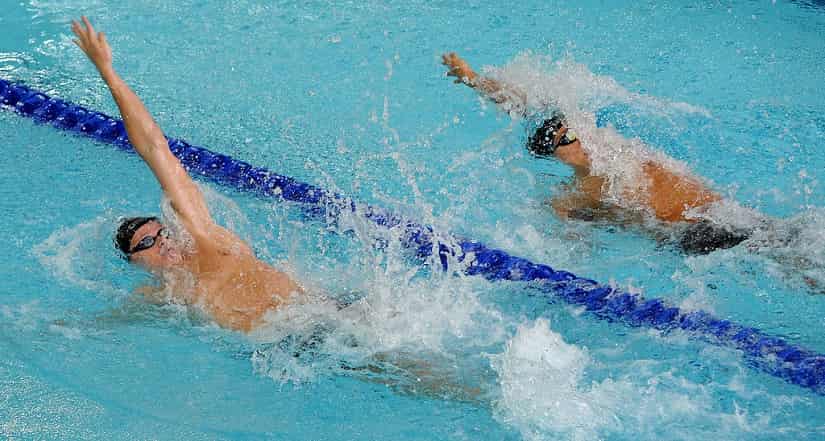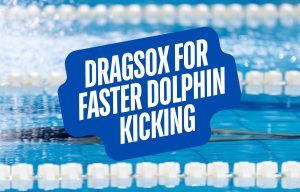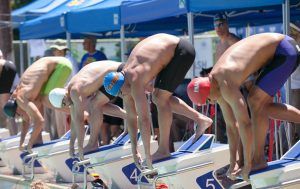Got a great question recently from a young swimmer via the YourSwimBook newsletter.
With a new season ahead of her, and a desire to make some big-time improvements in the pool, she was concerned about what she should be focusing more attention on: technique, or conditioning.
The answer?
Both.
Always.
No matter how advanced you are as an athlete you can always benefit from performing technical work in the water. Swimmers go mano-a-mano with water on the regular, no easy feat considering its 800 times denser than air. In order to slice through the water at a fast clip we need to be as efficient as possible.
By the same token, swimming is a resistance exercise, and one that requires great stamina and strength. In order to maintain that awesome technique, and do it repeatedly in practice, and then eventually in competition, we need to be properly conditioned.
See Also: How to Improve Your Feel for the Water
Technique and conditioning go hand in hand. It’s impossible to swim with perfect technique for long stretches without being in shape, and swimming with high intensity and shoddy technique makes it much, much harder.
One is powerless without the other.
The knowledge that you should be focusing on both of them should fuel your purpose and focus in practice. Everything you do while you are in the water, or during dryland should serve one of two objectives:
- Becoming a more efficient swimmer. This means spending less energy to go the same speed, or faster. Drill work falls under this category. So does swimming slowly but with perfect form.
- Becoming a better conditioned swimmer. Straightforward—you get into better shape. Stronger and better conditioned. Interval training, race pace stuff, and so on.
The Easiest Test Set to Track Improvement in the Water
So how can we measure these things? How can we know with absolute certainty that we are improving?
That’s where this test set comes in. It has three measurable components:
- How fast you perform each rep.
- How many strokes you take during each rep.
- The interval you use for each repetition.
Which means there are three different ways that you can progress through the set to better determine how you are improving.
How you end up doing this set will vary with how good of shape you are in, and more critically, what your specialty is. For distance swimmers simply take less rest between the 50’s instead of doing 100’s or 200’s. This will help you keep better track of the stroke rates and times (less numbers to remember).
Here is the set with sample intervals:
- 16×50 swim best average @1
or…
- 16×25 swim best average @:30
As mentioned previously, you want to track your times and stroke counts for each repetition.
So let’s say the first time you did the set you ended up with the following results:
16×50 freestyle best average @:55
- Avg. time: 32
- Avg stroke count: 34
The next time you do the set you would want to aim for a smaller stroke rate or time. You could also do it on a faster interval.
You can improve on a single marker, or all three.
Over the course of a season, if you are doing the test set regularly, you’ll be astonished at how you improve across the spectrum of measurables.
Tips for Making the Most Of This Set
- Aim for the same number of strokes per 50. Makes it a whole lot easier to remember your results. Same goes for dolphin kicks—don’t start off doing 7-8 underwater dolphin kicks off each wall only to finish with 1-2 by the end of the set. It’ll skew your stroke count big time.
- Write down the results as soon as you reasonably can. Get out of the water at the conclusion of the set, dry off your hands, and plug in your results into your training log. Don’t wait until you get home, or until the following day—write them out while the results are still fresh in your mind, and most importantly, they are still accurate.
- Perform the set in relatively similar settings. At the beginning of a new training cycle is a great time to do it, particularly after a big meet where swimmers are still feeling fast and fresh after a weekend of racing and a week or two of rest. Settings include the way you warm up for the set (regular meet warm-up vs. performing the set at the end of a 5,000m practice) and what stage of training you are in.
- Do the set a couple times to get a baseline. The first time swimmers do a test set they tend to swim it pretty conservatively. This is why doing the set 2-3 times in the span of a couple weeks, and then averaging out the results is a good idea, and will give you a more accurate baseline.
Why Doing Test Sets Is Important
For some swimmers the idea of having to compete in-practice is intimidating. They prefer to think of themselves as “practice swimmers” and would rather save the truly knock-down efforts for competition.
But there are some critical reasons why doing test sets is good for your development as a swimmer:
Fosters competition with yourself and your teammates. Competition with your teammates is good and healthy. Having someone there to push you when you are gasping for air between reps can be the thing to help shave a second off your average. Similarly, the big competition is with yourself. If you’ve been tracking the set properly you know exactly what you need to do in order to best it.
To recognize improvement and progression. This is the biggie—when a swimmer performs the test set faster it gives them a swimmer’s high that lasts for days. On the other hand, when a swimmer performs below their potential make sure to explain reason for slow performance (missed blocks of training, etc). If you train on your own, like I do, then test sets are even more imperative as they are the only true indicator of whether or not you are improving in the water.
Is good for mental prep as well as physical prep. Being able to get up and perform at any time, anywhere is one of those things that will separate you from the pack. The swimmer who needs conditions to be perfect in order to swim at their best is one that is easy to beat. A swimmer who can drop the hammer at a moment’s notice, on the other hand, provides a formidable challenge.














